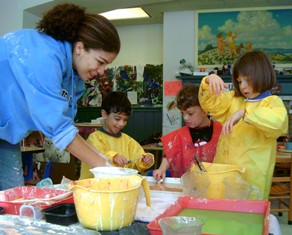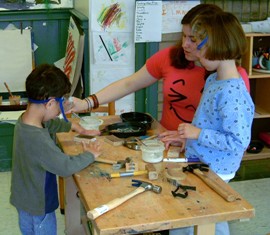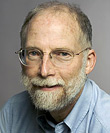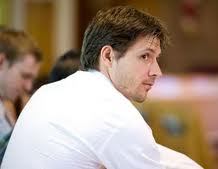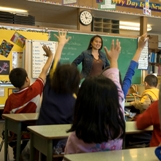By Roger Segelken
In press, Spring issue of Cornell Human Ecology Magazine
Remember the first time you saw the Periodic Table of Elements? It was probably hanging above the blackboard in high school chemistry class; the arrangement of its inscrutable rows of little boxes was supposed to reflect the properties of the elements—to help you “think like a scientist.”
But all you could think was: “I’ll never learn the difference between magnesium and manganese!” Or “Why can’t the symbol for lead be Ld?”
Middle-class students slog through, and with effective teaching, most come to see the wisdom of the Periodic Table. But poor kids in under-resourced schools lack the necessary scaffolding, and they opt out. For Wendy M. Williams, professor of human development, the Periodic Table of Elements and how it is traditionally taught have become a symbol for why disadvantaged youth have so much trouble turning on to science.
“In fact, the scientific method is a perfectly good way to do fact-finding, reasoning, and analysis about real-world problems of everyday life, and it is essential that we bring this message to underserved youth,” Williams says. “When and if kids get deeper into chemistry with the benefit of good teaching, they come to appreciate the Periodic Table as a thing of beauty and a useful tool. But if we tell them they have to learn the Periodic Table before they can think like a scientist, then most would rather not.”
And they will lose, perhaps forever, the chance to acquire skills they need, to discover for themselves the truth and what it means, and to be liberated from the “thought police”—television advertisers, closed-minded parents, or prejudiced schoolmates. They also lose a valuable mechanism for escaping the cycle of poverty through education and careers in science.
Thinking Like a Scientist (TLAS) is sounding better and better to schoolchildren across the United States who are exposed to curricula by that name.
The TLAS curriculum has been under development, with funding support from the National Science Foundation, in the Cornell Institute for Research on Children since 2002, with Williams and former graduate students Matthew C. Makel and David M. Biek as the principal authors. The lessons were tested first at inner-city schools and Indian reservations, where many children drop out before graduating from high school and few consider careers in the physical sciences and social sciences to be even a remote possibility.
The ultimate audience for TLAS, says Williams, co-director of the Cornell institute, are low-SES (socio-economic status) female and minority youth and young adults in high schools and community colleges. A secondary audience is the same population in community centers, religious organizations, and adult-education venues. Wendy Williams, herself, came from a disadvantaged background—she was a self-supporting high-school dropout at age 16, who earned a G.E.D. to enroll in college.
Fortunately for science, the young dropout’s potential was recognized; she got a second chance in the form of a scholarship from a school with ample resources, motivated students, and teachers with a passion for teaching. Williams wound up graduating cum laude with distinction from Columbia, earned two master’s degrees and a Ph.D. from Yale, garnered a slew of awards, authored dozens of articles and eight books, became a widely cited authority on the societal implications of intelligence, and co-founded the Cornell Institute for Research on Children.
Unfortunately—for millions of girls, minorities, and other at-risk kids— not every young person has the benefit of such an education. But virtually every school has some passionate teachers, even though resources are woefully inadequate, Williams insists. To prove the worth of TLAS, it was piloted in the toughest, neediest cases: in a five-week summer program for Chicago’s inner-city youth where 100 percent of the participants were kids on public assistance, and in 100 percent Native American Tribal Reservation high schools in North Dakota, among other locations.
After tests of the TLAS curricula in Arizona, North Dakota, Iowa, and Alabama, the project moves closer to home—for studies with black and Latino students in New York City and with poor white and Native American students in rural Saratoga County, N.Y. Pre-tests of scientific thinking ability are administered before the program, and post-tests are administered after the program, both to students in the program and to matched control students in neighboring classrooms. In every case, score improvements have been larger for students in TLAS classes.
Fact-Finding
Williams says that much of what is important in students’ lives is knowable; they can find out facts for themselves; and they can use proven information to make important decisions and changes in things that matter to them.
Many of the facts the TLAS students learn to uncover come from recently published meta-analyses in major scientific journals. They learn how scientific consensus is reached by the re-examination and conglomeration of previous, smaller studies.
The 13 modules in one current collection of TLAS materials cover a spectrum of social, physical, cognitive, and medical sciences. Each two-hour long module helps students discover, by doing, the many ways the scientific method can help answer questions: by defining the problem, seeing multiple sides of an issue, and distinguishing fact from opinion. They learn how to determine what constitutes evidence and how to weigh evidence and make decisions.
The 4 Rs of the Scientific Method
Students who have trouble making decisions seem to love the Four Rs of TLAS: Revisit, Reflect, Re-evaluate, and Review. For some, it is the first time they are encouraged to have “second thoughts” about anything.
When it came to choosing topics for the TLAS exercises, Williams tried to think like a curious kid. She and her graduate students built the lessons around questions such as “Effects of Violent Video Games: Do they Doom Kids to Mortal Kombat” (playing on the titles of two games), “Cigarettes: Stress Relief or Just a Bunch of Smoke?” and “Telling Lies: Can You Read It in Their Eyes?”
Some lessons are particularly—even uncomfortably— relevant to sensitive teenagers, such as “Depression: What Do We Do to Treat It?” Pregnant teens, who are at particular risk of dropping out, learn to apply some science to a question that most adults can’t answer: “Does Breastfeeding Make Babies Smarter Later in Life?”
And some topics are just plain fun, including “Is ESP For Real? I Knew You Were Going to Ask That!” and “Smiles in Women Versus Men: Who Smiles More and What Does It Mean?”
Left Behind vs. Racing Ahead
Who needs Thinking Like a Scientist?
“The TLAS curriculum does get the students involved in the biological and social sciences, and by training scientific thinking, it helps students do well on many parts of standardized tests,” Williams maintains, “and they really excel in tests that measure underlying thinking—not just what was taught, by rote, in class.” Examinations completed by students in schools using TLAS are shipped to the Cornell Institute for Research on Children, where the tests are scored using “blind” evaluations to eliminate possible bias from knowing which participants are “controls” and which are not.
Scores on tests of scientific thinking ability have shown greater improvements pre-test to post-test for students in TLAS classes compared to matched control students in neighboring classes, in various populations Williams has studied; among them, Native American Tribal reservation youth in North Dakota, African American and disadvantaged white youth in Alabama, Mexican-American and disadvantaged white youth in Arizona, and disadvantaged white youth in upstate New York. The tests are fair to all students because their questions tap scientific thinking and reasoning ability completely unrelated to the specific content of the educational modules.
If funding holds out, the Cornell Institute hopes to track TLAS “alumni” as they go to college (or join the workforce) to see if they get more remunerative jobs as a result of their science training.
Pathways to Success
Williams looks forward to comparing overall results from the TLAS project with results from another study she is doing, also focusing on helping disadvantaged youth. Her project called “Pathways to Success for Underrepresented Youth: A 50-Year Retrospective Longitudinal Study” is looking at “life course outcomes” for 600 mostly poor and minority individuals who attended the Telluride Association’s free summer enrichment program at Cornell at age 17, between 1954 and 2004.
“Fortunately for us, Telluride kept meticulous records on everything—high school transcripts, test scores, letters of recommendation, and reviews of each student’s work by Cornell faculty who supervised them,” Williams says. “We are now collecting current information about these people’s career trajectories, successes, and failures—and the factors they believe account for their escape from the limitations of their socioeconomic backgrounds.
“We are conducting extensive interviews with each of the Telluride enrichment program alumni— and we’re hearing some amazing stories,” Williams says. “This research will help answer a critical question: How we can help youth change the direction and eventual outcomes of their lives before it’s too late?”
Anecdotal Evidence Is Appreciated
Staying in constant e-mail touch with the far-flung TLAS test sites, Williams hears that teachers are “enjoying” the process and that students are “excited” to discover that science can have some relevance to their lives.
For Williams, this is sure nice to hear while burning the midnight oil with a bunch of correlation coefficients, regressions toward the mean, and those darn confounding factors. No one ever said science was easy. It ought to be relevant, though.
Gratifying is not so bad either.
For More Information on Thinking Like a Scientist
Visit the CIRC website:
Contact , wmw5@cornell.edu
Human Development Today e-News
Human Development Outreach & Extension
